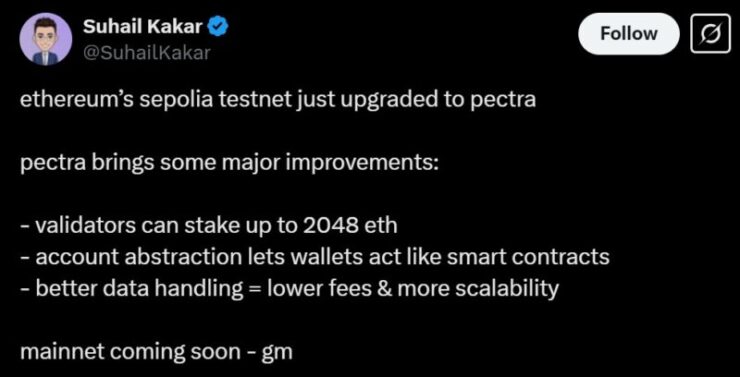Ethereum’s highly anticipated Pectra upgrade has successfully passed its test on the Sepolia testnet, bringing it one step closer to being deployed on the mainnet. This upgrade, which is the most significant for Ethereum since 2024, introduces several major features aimed at improving the network’s functionality and efficiency, particularly for staking and wallet management.
Following this Testnet, Ethereum developers are gearing up for a crucial meeting on March 6 to discuss the timeline for the Pectra upgrade’s mainnet release. Despite the success of the Sepolia test, developers are contemplating whether to delay the mainnet deployment to ensure system stability, as only one fully successful test has been completed. The decision will hinge on ensuring that Ethereum’s network remains robust and secure as it moves toward this significant upgrade.
One of the most important proposals in the Pectra upgrade is EIP-7251, which addresses the current inefficiencies in Ethereum’s staking process. By increasing the maximum amount of ETH that validators can stake from 32 to 2,048, the proposal allows validators to consolidate their stakes and eliminates the need to split large stakes across multiple nodes. This change is expected to simplify staking and improve the scalability of Ethereum’s network, making it more accessible for validators with larger holdings.
Another highly anticipated feature of the upgrade is EIP-7702, which would allow crypto wallets to temporarily function as smart contracts. This proposal brings Ethereum closer to full account abstraction, a system that would enable wallets to offer enhanced user features. With EIP-7702, users could pay transaction fees in stablecoins instead of ETH, set up automatic payments for recurring subscriptions, or recover wallet access without relying on complex seed phrases. This shift would significantly improve the user experience, making Ethereum more accessible to both novice and experienced users.

Testnet Challenges and Delays
Sepolia’s successful upgrade at 07:29:36 UTC signals progress for Ethereum’s next major upgrade. Despite this successful deployment on Sepolia, the upgrade’s journey hasn’t been without challenges. Last week, a test on Ethereum’s Holesky testnet failed due to a misconfiguration among validators. Holesky was expected to be the critical testing ground for Pectra due to its validator structure, which closely mirrors Ethereum’s mainnet. However, a misconfiguration among validators caused a chain split, making the Holesky network temporarily unusable. Developers are still working to get Holesky back online, with an alternative developer network now in place to continue testing until Holesky is fully operational again.
While the Sepolia test was successful, developers are taking extra precautions to ensure the mainnet release is stable. The meeting on March 6 will discuss whether any delays are needed to ensure a smooth transition.
Market Impact and Industry Trends
Ethereum’s Pectra upgrade comes at a time when the network faces increasing competition from newer blockchains like Solana, which has gained significant traction for its speed and low fees. However, with Ethereum’s dominance in decentralized finance (DeFi) and its ongoing upgrades, Pectra could reinforce its position as a leader in the smart contract space.
Quick Facts:
- Ethereum’s highly anticipated Pectra upgrade has successfully passed its test on the Sepolia testnet.
- Pectra introduces EIP-7251, increasing the maximum ETH stake for validators from 32 to 2,048 ETH.
- EIP-7702 will enable wallets to function as smart contracts, offering new features like transaction fee payments in stablecoins.
- Despite a failed test on the Holesky network, the Sepolia test was a success, and the mainnet rollout is approaching.





